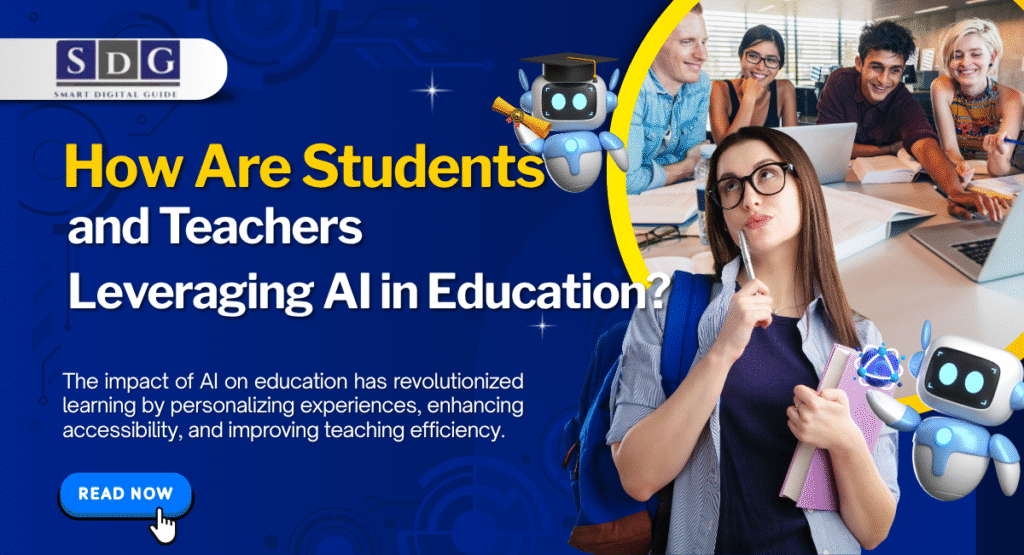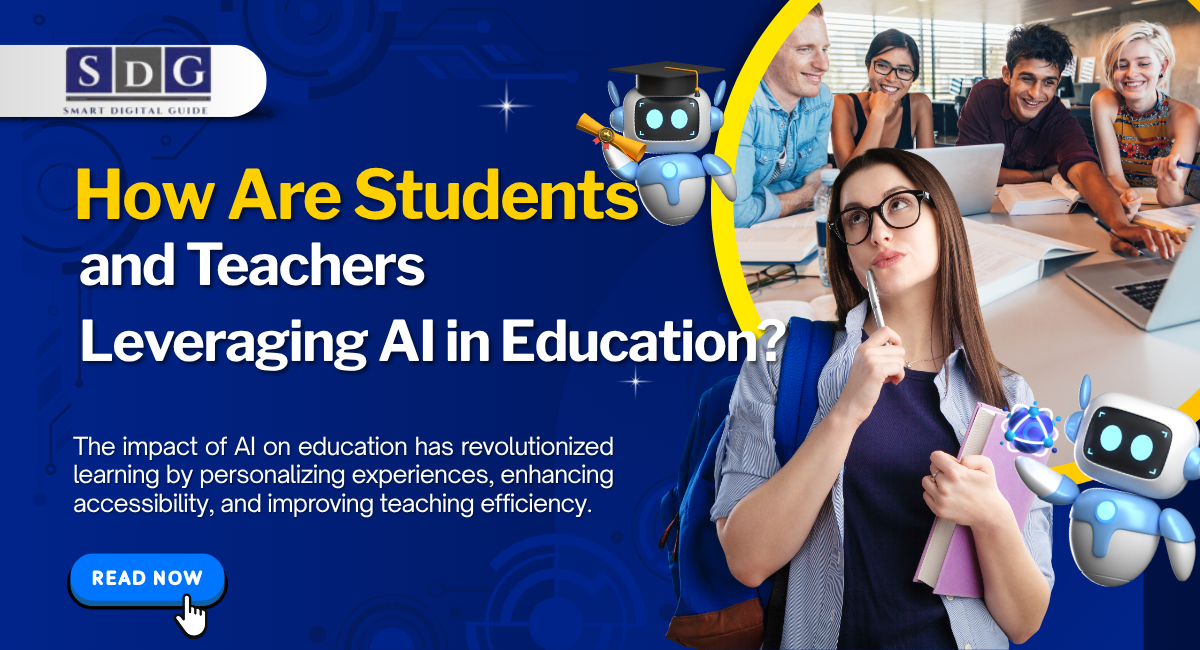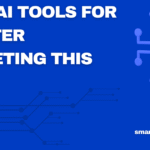Artificial Intelligence (AI) has emerged as a significant force influencing contemporary education. Through personalized learning experiences and automated evaluation processes, AI is revolutionizing both the student learning experience and teaching methodologies. As smart technology continues to advance, integrating AI into educational practices is evolving from a mere trend to an essential component. In this article, Smart Digital Guide examines how educators and learners are utilizing AI in the classroom to enhance effectiveness, engagement, and accessibility in the learning journey.

1. Introduction: The Rise of AI in Education
Education is experiencing rapid changes, primarily driven by artificial intelligence. At present, AI tools are making it simpler for students to access essential resources and providing improved assistance to educators. Through AI-based tutoring platforms and virtual classrooms, technology is bridging the gaps found in traditional educational systems. How are students and teachers leveraging AI within their learning settings? Let’s delve into its true impact.
2. Personalized Learning with AI
A major benefit of AI in the realm of education lies in its capacity to personalize learning experiences. In contrast to traditional classrooms, where all students move at a uniform pace, tools powered by AI assess individual strengths and weaknesses to deliver customized solutions.
How Students Benefit:
- Applications powered by AI, such as Duolingo and Khan Academy, tailor lessons to match the pace at which each student learns.
- Students obtain immediate feedback on tests and assignments.
- AI supports learners in concentrating on areas they struggle with, enhancing their overall comprehension.
Benefits for Teachers:
- Educators can leverage AI analytics to recognize students requiring additional support.
- AI produces progress reports on students, minimizing the need for manual tasks.
- It assists in developing tailored learning strategies for individual learners.
Thanks to this technology, personalized education has transitioned from a concept to an achievable reality.
3. AI-Powered Virtual Assistants
AI-powered virtual assistants are progressively becoming essential in online education. These tools support both learners and educators in enhancing productivity and managing their time more effectively.
- For Students: Virtual assistants address frequently asked questions, help with assignments, and offer thorough explanations. Tools such as ChatGPT are becoming increasingly favored for research assistance and improving study techniques.
- For Teachers: AI chatbots handle repetitive administrative tasks, such as scheduling, grading, or responding to student inquiries. This allows teachers to devote more attention to teaching.
The incorporation of AI into educational environments through virtual assistants is creating a faster, engaging, and less intimidating learning experience.
4. Automating Administrative Work
Teachers often invest considerable time in administrative duties, including the development of exam papers, grading assignments, and managing student records. Fortunately, many of these processes can now be automated thanks to advancements in AI technology.
- AI grading tools are capable of effectively evaluating both multiple-choice questions and written essays.
- Moreover, AI can assist in scheduling exams, sending reminders, and monitoring attendance.
- Consequently, instructors have more time to focus on creating engaging lesson plans and innovative teaching strategies.
For students, this transformation results in quicker feedback and shorter wait times for their grades, which boosts their motivation and participation in learning activities.
5. Intelligent Tutoring Systems
AI-based tutoring platforms act as personalized educators for every student. Through the use of machine learning, these systems adjust their methods according to each learner’s progress and offer continuous support throughout their educational journey.
- Students can practice various subjects, including math, programming, or science, with AI tutors accessible 24/7.
- These platforms feature interactive videos, tests, and exercises designed to enhance problem-solving skills.
- Teachers have the ability to monitor student participation on these platforms and provide additional help when necessary.
The combination of AI tutoring with conventional classroom teaching is raising educational standards around the world.
6. Breaking Language Barriers
Language often presents a challenge in global education, but AI is effectively tackling this concern. Translation tools and speech-to-text applications allow students from diverse linguistic backgrounds to engage with educational material.
- Students can instantly translate textbooks or online courses into their native languages.
- Teachers can make use of AI-powered language assistants to communicate with learners from various regions.
This aspect of integrating AI in education is particularly beneficial in countries where students struggle with English or other foreign languages.
7. Virtual Reality (VR) and AI in Classrooms
The integration of AI and VR technology is revolutionizing the way we learn by providing immersive educational experiences. Picture exploring historical events through virtual tours of ancient sites or studying biology with interactive 3D models of human anatomy.
- Students: Grasp difficult subjects with simulations, simplifying their comprehension.
- Teachers: Employ AI to craft dynamic lessons that captivate students and enhance memory retention.
This methodology is transforming conventional teaching techniques, making education both more applicable and enjoyable.
8. Predictive Analytics for Better Learning Outcomes
AI can analyze large volumes of student data and anticipate future results.
- For Students: AI tools suggest additional resources to improve specific areas where they may struggle.
- For Teachers: They receive alerts regarding students who might be at risk of lagging, allowing for prompt intervention.
Predictive analytics enables teachers to make well-informed choices grounded in data, guaranteeing that each student gets the support they need.
9. Challenges of AI in Education
Integrating AI into educational environments presents significant advantages, but it also brings forth numerous challenges:
- The high expenses linked to the implementation of AI resources in both schools and higher education institutions.
- Concerns about safeguarding students’ personal data.A potential dependency on technology that could diminish face-to-face interactions during the learning process.
It is crucial for educators and policymakers to strike a proper balance between AI-enhanced teaching strategies and conventional approaches to enhance overall effectiveness.
10. The Future of AI in Education
In the coming years, it is expected that artificial intelligence will have a greater impact on education. With advancements in machine learning and automation, the educational experience is projected to become more personalized and engaging. Future classrooms powered by AI could include:
- Fully automated grading and reporting systems.
- AI mentors guiding students in their career decisions.
- Virtual schools accessible from anywhere around the world.
Smart Digital Guide foresees a future where education integrates technology with a personal touch. Instead of taking over the role of teachers, AI seeks to support them in creating a smarter and more efficient learning environment.
Final Thoughts
The incorporation of AI in the educational sector is revolutionizing how students acquire knowledge and how instructors deliver lessons. With advancements such as tailored learning experiences, virtual teaching aids, and predictive data analysis, AI is enhancing education by making it more intelligent, efficient, and reachable. Although there are hurdles to overcome, the advantages significantly surpass any disadvantages.
As artificial intelligence progresses further, both learners and educators will uncover innovative methods to utilize this technology for improved outcomes. At Smart Digital Guide, we urge educational institutions and teachers to welcome AI innovations and get ready for a future where technology integrates seamlessly with education.









